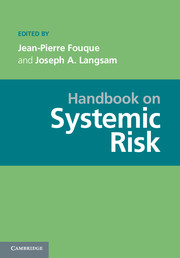Book contents
- Frontmatter
- Contents
- Contributors
- Introduction
- PART I DATA: THE PREREQUISITE FOR MANAGING SYSTEMIC RISK
- PART II STATISTICS AND SYSTEMIC RISK
- PART III MEASURING AND REGULATING SYSTEMIC RISK
- PART IV NETWORKS
- 11 Network Models and Systemic Risk Assessment
- 12 Strategic Interactions on Financial Networks for the Analysis of Systemic Risk
- 13 Network Structure and Systemic Risk in Banking Systems
- PART V SYSTEMIC RISK ANDMATHEMATICAL FINANCE
- PART VI COUNTERPARTY RISK AND SYSTEMIC RISK
- PART VII ALGORITHMIC TRADING
- PART VIII BEHAVIORAL FINANCE: THE PSYCHOLOGICAL DIMENSION OF SYSTEMIC RISK
- PART IX REGULATION
- PART X COMPUTATIONAL ISSUES AND REQUIREMENTS
- PART XI ACCOUNTING ISSUES
- References
13 - Network Structure and Systemic Risk in Banking Systems
from PART IV - NETWORKS
Published online by Cambridge University Press: 05 June 2013
- Frontmatter
- Contents
- Contributors
- Introduction
- PART I DATA: THE PREREQUISITE FOR MANAGING SYSTEMIC RISK
- PART II STATISTICS AND SYSTEMIC RISK
- PART III MEASURING AND REGULATING SYSTEMIC RISK
- PART IV NETWORKS
- 11 Network Models and Systemic Risk Assessment
- 12 Strategic Interactions on Financial Networks for the Analysis of Systemic Risk
- 13 Network Structure and Systemic Risk in Banking Systems
- PART V SYSTEMIC RISK ANDMATHEMATICAL FINANCE
- PART VI COUNTERPARTY RISK AND SYSTEMIC RISK
- PART VII ALGORITHMIC TRADING
- PART VIII BEHAVIORAL FINANCE: THE PSYCHOLOGICAL DIMENSION OF SYSTEMIC RISK
- PART IX REGULATION
- PART X COMPUTATIONAL ISSUES AND REQUIREMENTS
- PART XI ACCOUNTING ISSUES
- References
Summary
Abstract We present a quantitative methodology for analyzing the potential for contagion and systemic risk in a network of interlinked financial institutions, using a metric for the systemic importance of institutions: the Contagion Index.
We apply this methodology to a data set of mutual exposures and capital levels of financial institutions in Brazil in 2007 and 2008, and analyze the role of balance sheet size and network structure in each institution's contribution to systemic risk. Our results emphasize the contribution of heterogeneity in network structure and concentration of counterparty exposures to a given institution in explaining its systemic importance. These observations plead for capital requirements which depend on exposures, rather than aggregate balance sheet size, and which target systemically important institutions.
Keywords Default risk, domino effects, balance sheet contagion, scale-free network, default contagion, systemic risk, macro-prudential regulation, random graph.
Introduction
The recent financial crisis has emphasized the importance of systemic risk, defined as macro-level risk which can impair the stability of the entire financial system. Bank failures have led in recent years to a disruption of the financial system and a significant spillover of financial distress to the larger economy (Hellwig, 2009). Regulators have had great difficulties anticipating the impact of defaults partly due to a lack of visibility on the structure of the financial system as well as a lack of a methodology for monitoring systemic risk. The complexity of the contemporary financial systems makes it a challenge to define adequate indicators of systemic risk that could help in an objective assessment of the systemic importance of financial institutions and an objective framework for assessing the efficiency of macro-prudential policies.
- Type
- Chapter
- Information
- Handbook on Systemic Risk , pp. 327 - 368Publisher: Cambridge University PressPrint publication year: 2013
References
- 162
- Cited by

